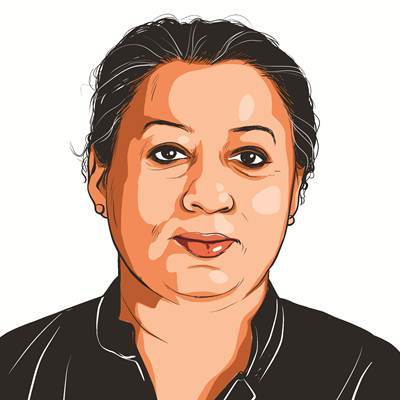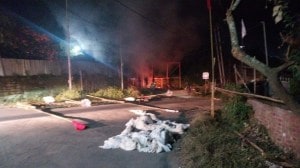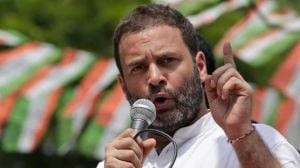Ritu Sarin is Executive Editor (News and Investigations) at The Indian Express group. Her areas of specialisation include internal security, money laundering and corruption. Sarin is one of India’s most renowned reporters and has a career in journalism of over four decades. She is a member of the International Consortium of Investigative Journalists (ICIJ) since 1999 and since early 2023, a member of its Board of Directors. She has also been a founder member of the ICIJ Network Committee (INC). She has, to begin with, alone, and later led teams which have worked on ICIJ’s Offshore Leaks, Swiss Leaks, the Pulitzer Prize winning Panama Papers, Paradise Papers, Implant Files, Fincen Files, Pandora Papers, the Uber Files and Deforestation Inc. She has conducted investigative journalism workshops and addressed investigative journalism conferences with a specialisation on collaborative journalism in several countries. ... Read More
Jain `spares’ Tamils but says Karunanidhi should’ve been questioned
NEW DELHI, July 12: The interim report of the Justice M.C. Jain commission created a storm and ended a government. A few months later, Justi...

NEW DELHI, July 12: The interim report of the Justice M.C. Jain commission created a storm and ended a government. A few months later, Justice Jain has made a turnaround and has backtracked on some of his controversial comments.
A brief chapter in the final report titled `Deep nexus with Tamils’ shows the the volte-face on the support for the LTTE in Tamil Nadu. Jain had asserted in the interim report that the assassination of former Prime Minister Rajiv Gandhi would not have been possible without the “active connivance and support of the Tamils of Tamil Nadu.”
He now says that the expression “deep nexus” was meant for “very few” and not the entire Tamil population. He clarifies: “The expression deep nexus was never and could never have been intended to mean that such nexus was with all Tamil-speaking people of Tamil Nadu. All the Tamilians of Tamil Nadu might not even be in the know of the activities and operations of the LTTE.
When they are not even in the know of, how can there be a deepnexus?”Jain reiterates the point several times and attempts to give a logical explanation for the callous remarks included in the interim report. “It the (the LTTE) did enjoy moral and material support in Tamil Nadu. This is amply borne out by the investigation records…but the deep nexus could only be with very few..”
What kicked off the controversy and triggered the chain reaction which led to the fall of the I.K. Gujral government was Jain’s alleged “indictment” of M. Karunanidhi’s DMK. Jain now clarifies: “There is no indictment in the interim report of any individual or organisation or any party regarding the assassination of Rajiv Gandhi.”
He also says the commission had inquired into the allegations that the DMK had printed posters hinting at the tragedy a day before the assassination and found them to be “baseless.”
However, Jain says, further proof had come to the commission about the “rear base” and facilitation being given to the LTTE cadres during the DMK regime. He says this hasbeen further borne out by reports of the Subsidary Intelligence Bureau (SIB), Madras which were given to the commission after the submission of the interim report.
The reports, dealing with the period 1989-91, trace the movement boats and arrival of arms in coastal Tamil Nadu as well as give proof of the logistical and medical assistance that was readily being given to LTTE cadres. The intelligence reports, reinforce the allegations that the LTTE had a fertile ground in the Tamil Nadu for its operations during the DMK rule.
The report shows that the Ministry of Home Affairs (MHA) had been kept informed about the “material and moral” support to the LTTE from DMK sympathisers.
One such message, sent by the Additional Director of the Intelligence Bureau (IB) to the Home Secretary on January 30, 1990. The report quotes the letter: “The LTTE has been taking full advantage of the sympathies of the DMK in Tamil Nadu…local DMK leaders in the coastal region of Thanjavur have also been collaborating with theLTTE in their illegal trafficking and activities…”
Jain says it is for this reason that he felt the Tamil Nadu Chief Minister, M. Karunanidhi should have been among the politicians who were questioned by the Special Investigating Team (SIT), which did the police investigations in the case.
“On many matters his interrogation was quite relevant.”
When Jain deals with his list of “additional suspects” in the assassination case (Volume IV) he prefers to refer to them as the “supporters of chauvinist groups.” There are 21 persons who figure in his fresh list of “suspects” which is going to be made public almost seven years after the assassination. Jain says the Special Investigating Team should have filed supplementary charge-sheet against them.
There are 11 Sri Lankans and 10 Indians on the list. Among the Indians is one former DMK minister Subbulakshmi Jagadishan and six activists of politicians from the Dravida Kazhagam (DK). Justice Jain has asked the Government to “adopt such course ofaction as it may think fit,” against the list of “suspects” in the Rajiv Gandhi assassination case.
Paving the way for additional chargesheets being filed, Justice Jain explains that, this, would in no manner effect the original case against 41 accused persons.
He says, “the trial by the designated court was only in respect of the 41 persons arraigned as accused by the Special Investigating Team. It was not within the trial court to look beyond the 41 accused, so the question of exonerating others who did not figure in the charge-sheet did not exist.”Jain says that contrary to the assertion (during deposition) of the SIT Chief, D.R. Karthikeyan, that there “is little scope of involvement of any other persons,” his conclusion was that the SIT should have filed supplementary charge-sheets against a “large number” of persons.
He alleges that the SIT left “several” gaps in the investigation and in many areas left several areas and allegations either “uninvestigated” or“half-investigated.”
Justice Jain’s list of additional suspects includes, Kittu, Baby Subramaniam
Justice Jain says that the evidence that has been presented to him ever since the commission was set up shows the role and complicity of 21 persons in the assassination needs,“ further scrutiny, examination and action in accordance with law”.
They are:
SRI LANKANS
INDIANS
Photos




- 01
- 02
- 03
- 04
- 05




























